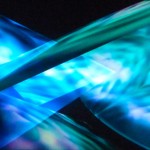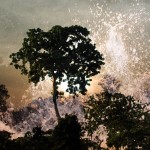Images are stereoscopic for cross-eyed free-viewing
Green Space is a stereoscopic animation and installation based on 3D still photographs of nature. The artist put them into motion, layering them similar to the way our brains combine stored images in the mind when recalling our experiences. In 3D the organic shapes become sculptural and volumetric, and they can transform in time as they do in our minds when remembering and thinking: non-linear, juxtaposed, cyclic patterns, rhythms, and movements, like a stream-of-consciousness poem or improvised dance.
Animation puts stored memories into our conscious awareness as a series of new moments, representing the continuation of life. In Green Space, some of the plants become snakelike and reinforce dynamic cycles of life, death, and rebirth. The Buddhist Tree of Life (8th Century, Borobudur, Java, Indonesia), carved in stone, reinforces the interconnection of all life on Earth. There is no such thing as “empty” space, as there is always a past and a potential future to “fill” it. The three empty chairs are filled by the memories of people who passed away, but also by new life. The line drawings at the beginning and end represent the eyes and gestures of the artist and viewers, who are not only witnesses to, but participants in life. The garden is the foundation and the setting, a place of hope and healing. The church at the beginning signals the spiritual quality of this piece as it provides a space for contemplation.
The physical installation is meant to extend the space beyond the screen, and vice versa with real plants, real bodies and real memories, merging all into a continuous whole that is not only an illusion of life. Everything in this work is positioned inside a garden, the garden that is life, the garden in our minds, reflexively and recursively. Green Space is therefore a meditation on time, space, and life.
The use of stereoscopy in Green Space heightens the illusion of subjective reality, affected by the feelings and thoughts of the viewer. We always know that we are watching a stereoscopic movie and that it is an illusion. This is similar to the illusion we have that life is permanent and the physical world immutable. But as we age we learn that all things must change and pass. So there is simultaneously a tragic and optimistic aspect to stereo 3D. Green Space uses this quality to comment on the conflict between permanence and impermanence of life and the “real world”.
Green Space is an homage to the artist’s parents and best friends, Doris and Søren Sørensen, and her uncle Mogens Sørensen, who passed away while she was creating this work. The accompanying music was composed and performed by David Blonski and Daryl Simmons, and is from the CD The Bells of Arcosanti. Arcosanti was an ideal social community and bronze bell foundry built in the wilderness of Arizona starting in 1970 by the late Italian-American architect Paulo Soleri, who pioneered the concept of arcology, the combination of architecture and ecology. This work is also an homage to his life and memory.
The artist would like to thank Mr. Nagaraju Thummanapalli for his special technical assistance with this project.
Vibeke Sørensen
September 22, 2013
Professor and Chair
School of Art, Design and Media
Nanyang Technological University
Singapore



